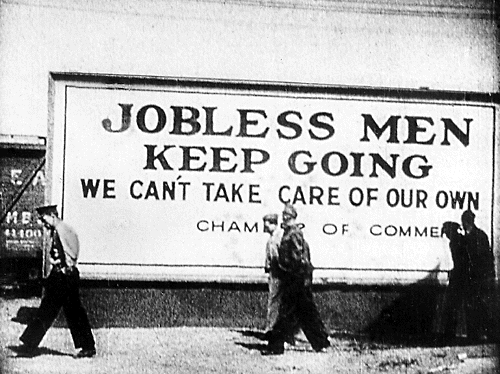
In the Wall Street Journal, Sean McCann explores some of the parallels between the current economic crisis and the Great Depression, asking the timely question, “Will This Crisis Produce a ‘Gatsby’?” As fascinating as the literary implications are/could be, what’s most interesting are the paraphrases from Sherwood Anderson’s 1935 essay collection, Puzzled America, which articulates the Imperative/Law at the heart of the American Dream, or American Theory of Life in all its oppressive glory, and how it was punctured during that decade. Rather than inspiring people during the Depression to get back on their feet, American self-understanding actually imprisoned and paralyzed them. With all the talk these days of how the indomitable American Spirit will pull us through and out of this recession, Anderson’s observations provide some much-needed reality check about where we should, or shouldn’t, be looking for rescue. That the disillusionment might spill over into the creative realm, as McCann suggests, would certainly be a bonus!
In the fall of 1933, Sherwood Anderson left his home in New York City and set out on a series of journeys that would take him across large sections of the American South and Midwest. He was engaged in a project shared by many of his fellow writers… respond[ing] to the Great Depression by traveling the nation’s back roads and hinterlands hoping to discover how economic disaster had affected the common people. Like many of his peers, Anderson had anticipated anger and radicalism among the poor and unemployed. Instead, he discovered a people stunned by the collapse of their most cherished beliefs. “Puzzled America,” the title of the book he composed out of his journeys, said it all.
In particular, Anderson found the people he met to be imprisoned by what he called the “American theory of life”–a celebration of personal ambition that now seems cruelly inappropriate. “We Americans have all been taught from childhood,” Anderson wrote, “that it is a sort of moral obligation for each of us to rise, to get up in the world.” In the crisis of the Depression, however, that belief appeared absurd. The United States confronted what Anderson called “a crisis of belief.”
The notion that the United States is a uniquely open society, where the talented and industrious always have the chance to better their lot, is a central element of American self-understanding. The notion has been a prominent feature of American culture since the days of Ben Franklin, and it remains a core feature of the national ethos to this day…
The conflict between the American myth of a classless society and the reality of the nation’s deepening caste divisions was the irony at the core of some of the greatest literary works of the 1920s, including Theodore Dreiser’s “An American Tragedy” and F. Scott Fitzgerald’s “The Great Gatsby.” But it was not until the Great Depression that the traditional vision of social mobility imploded.
Traveling the country, Anderson and his fellow observers found a populace confused by a collapse they could not understand. Everywhere he turned, Anderson noted, he heard the same refrain, “I failed. I failed. It’s my own fault.” The documentary books that he and his contemporaries created provided a kind of counter-narrative to the conventional American story of personal freedom and individual ambition. These works featured a journey not upward toward wealth and progress, but back into the hinterlands of a confused and immobilized nation.

COMMENTS
One response to “Depressions, Recessions, and the American Theory of Life”
Leave a Reply














Thanks, Drake. Sherwood Anderson is da bomb, for sure.
His portrait of a small town in the short story collection WINESBURG, OHIO is amazing.